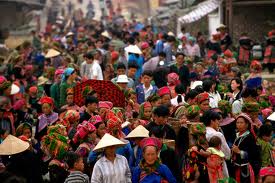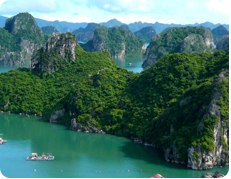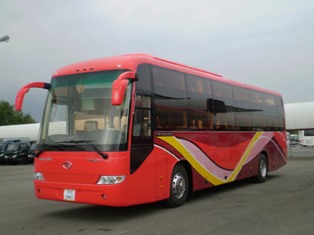SAPA HILL TRIBE TREK & HOMESTAY TOUR
Tour Code : SHT 05
5 Days/6nights - Daily Departure from Hanoi or Sapa
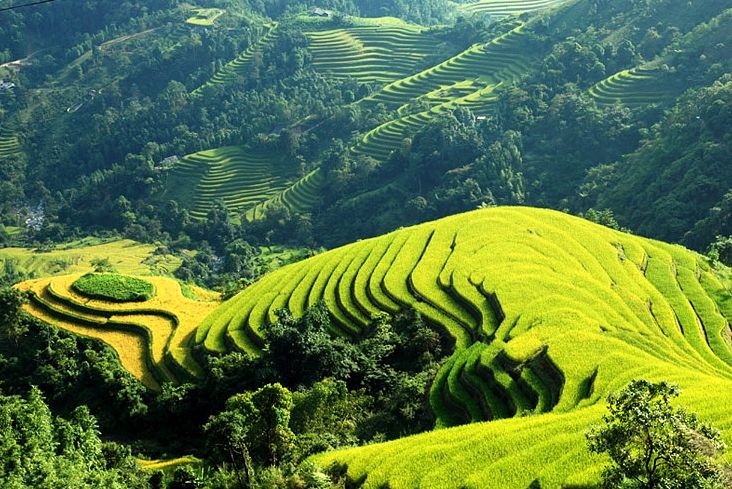
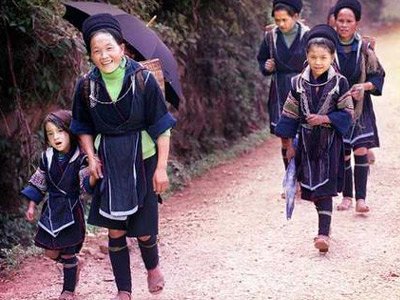
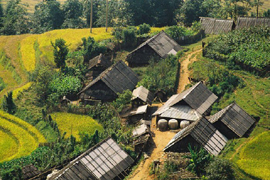
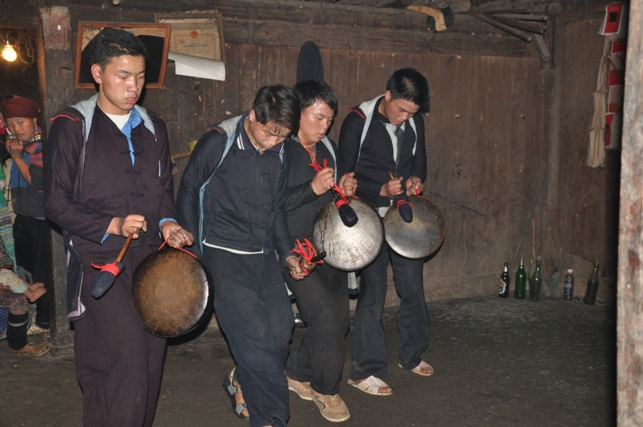
Itinerary:
Please, be ready at your hotel lobby at 19h.30 for a short transfer to Hanoi railways station for taking the overnight train (first class 4 beds cabin with air-condition) which arrive in Lao Cai city, near the Chinese border next morning.
Day 1: Sapa - Tavan - Seomity (-, L, D)
Pick up from Lao Cai station and transfer to Sapa for breakfast ,after breakfast Sapa local guide and driver then transferred to Muong Hoa valley. Your trek will begin from Tavan village of Giay minority. The first day trek will be mostly uphill. Whenever you stop for a rest, you will be able to enjoy valley view. Before noon, you stop again at a nice spot for lunch. The trek will be softer in the afternoon. But the scenery becomes even more beautiful. You pass by Seomity village of Black Hmong minority before you arrive at the campsite, which locates nearby a river outside the village. While porters put up tents and cook dinner, you can take a walk to stretch the legs.
Approx: 0,5 hour driving/ 4,5 hours walking/ 1 hour lunch
Day 2: Seomity – Den Thang - Ta Trung Ho (B, L, D)
The trek today takes you through beautiful rice paddies and over old suspension bridges. You will trek on small trail sneaking through rainforest. You arrive in Den Thang village of Black Hmong by noon. Here you stop for lunch either nearby a river or in a local school according to the weather. After lunch, the trek will becomes tough on tinny footpath going up and down, which requires a lot of concentration. You will reach to Ta Trung Ho village of Red Dao minority where you spend the night in local house. Both the valley and the village have just received foreign visitors. The night will be even more interesting when you are in the wonderful hospitable atmosphere of the Red Dao
Approx: 7 hours walking/ 1-hour lunch
Day 3: Ta Trung Ho – Nam Toong – Thanh Phu (B, L, D)
You are now at the fringe of the rain forest by the Hoang Lien Son mountain range. Fansipan, the highest peak in Indochina with its 3143 m, is located in this mountain range. You will start the trek today by ascending to Nam Toong village of Red Dao minority. Here your lunch will be prepared in a local school. After lunchtime, you descend to the valley where locates My Son village of Xa Pho minority, one of the smallest groups ethnic in Northern Vietnam. From there you take a short walk to Thanh Phu village of Tay minority. Here you spend the night in traditional house of the Tay. You can take a walk to explore local daily life while your dinner will be served with Vietnamese dishes.
Approx: 6 hours walking/ 1-hour lunch
Day 4: Thanh Phu - Nam Cum – Sin Chai (B, L, D)
Today’s trek will be relatively short and soft. Once leaving Thanh Phu, you follow the trekking route built in the bottom of the valley, which offers the best view to the surrounding mountains. You stop at a nice spot for lunch. After lunchtime, you continue the walk toward Sin Chai village of Red Dao minority where the night will be spent in the Red Dao village.
Approx: Grade 2 of 5/ 3 hours walking/ 1-hour lunch
Day 5: Sin Chai - Thanh Phu – Ban Ho – Sapa (B, L, -)
Once having left Sin Chai you will start heading towards Ban Ho. You will trek along the riverbank where you can enjoy a refreshing swim nearby a waterfall. At Ban Ho, your lunch will be prepared and served in a friendly local Tay family's house. On the last hours you can enjoy the valley view one final time while trekking upward Supan. Here your car will take you on journey back to Sapa. On the way you still have many opportunities to enjoy magnificent views of valleys and mountain. 16h30 Transfer to station for overnight train back Hanoi .Arrive around 5h30 AM .The end of great trip !
Approx: 1-hour driving/ 5 hours walking/ 1-hour lunch.
Price :
| Group Size | 01pax | 02pax | 03pax | 04pax | 05pax |
|---|---|---|---|---|---|
| Cost in US$ | 750 | 550 | 530 | 495 | 480 |
What's Included in the Tour Cost :
- English or French speaking guide (Surchage for French speaking guide $.10/day)
- Round Trip Train Tickets from Hanoi ( Deluxe Soft Sleeper 4Berth Cabin - 2berth Cabin requested and pay extra )
- Black Hmong porters (to carry food and luggage)
- Cook (from group sizes of 6 pax)
- All needed transport
- All indicated meals, plus snacks (B as breakfast; L as lunch; D as dinner)
- Water on the whole trip
- Sleeping bag and mattresses
- Waterproof bluebag for luggage
- Tents if needed
- Mosquito net
- All entrance fees and permit
- Overnight in local house or tent
What's Not Included in the Tour Cost :
- Personal Pocket Money
- Soft drink (beer, coca cola…)
- Insurance
- All other services not indicated above
What to bring :
- Sun Block
- Wide brim hat
- Camera + Film
- Comfortable shoes
- Rain gear
- Warm clothes
- Insect Repellent
- Original Passport
Sapa Vietnam
-- Located in North-West Vietnam , Sapa is the most attractive mountain place must be visited on any northern Vietnam itinerary. On a clear day you will treated to views of steeply terraced rice fields, towering verdant ridgelines, primitive mud-thatched villages, raging rivers and astounding waterfalls. Nestled high in the Tonkinese Alps near the Chinese border, Sape was built as a hill station during French colonial days, to serve as a respite from stifling Hanoi summers. These days, weekends are still the biggest draw in this crumbling hill-tribe center. Visitors from the capital flock to Sapa for a glimpse of the famed "Love Market," a trek to local hill tribe villages, or an ascent of Vietnam's highest peak, Fan Si Pan. Some eight ethnic groups inhabit Lao Cai province: Hmong, Dao, White Thai, Giay, Tay, Muong, Hao and Xa Pho. The most prominent in town are the Red Dao, easily identified by the coin-dangling red headdresses and intricately embroidered waistcoats worn by the women, and the Hmong, distinguished by their somewhat less elaborately embroidered royal blue attire.

Groups of ethnic Hmong youngsters and women can be seen hauling impossibly heavy, awkward baskets of wood, stakes, bamboo, bricks, mud and produce. Deep in the valleys surrounding Sapa, the Muong Hoa River sluices a wild, jagged course among Giay, Red Dao and White Thai settlements, their tiny dwellings poking out of the neon rice fields like diamonds on a putting green. One- to four-day treks are offered by a handful of outfitters. Guests sleep in tents or in the homes of villagers, their gear hauled by Hmong porters. Be warned: Despite what the local innkeepers will tell you, both the Hmong and the Dao really do not enjoy having their photographs taken unless they're paid for it. It's a certainty that any brochure you see of smiling, care-free ethnic hill people was shot under a Screen Actors Guild contract.
Sprawling near the banks of a river, Can Cau Market is a clearly defined shantytown, packed with crude stalls covered with thatched roofs. The start of a few simple settlements can be seen high above, many of whose residents now make their weekly pilgrimage to the market. We are only 9kms from the Chinese border and some traders make the journey across from China on horseback. Unfortunately foreigners are not allowed to reciprocate this set-up, however tempting it may seem. By 9 am, the market is crammed to capacity. It's lively and surprisingly fun. The locals are mostly of the Flower Hmong minority group. You can't miss them -their traditional costume of green checked headdress and multi-colored, meticiculosly stitched and layered garments are simply stunning. Few foreigners make it to Can Cau; those that do brave the journey come either with a small tour group in four-wheel drives, or - if half-mad and on a tight budget like me -on the back of a motorbike.

The handful of Westerners here this morning are the object of intense - though friendly- scrutiny. There is much laughter as we try to make basic conversation. Although the majority are painfully shy and not accustomed to seeing foreigners, some cheerfully allow photographs to be taken.
